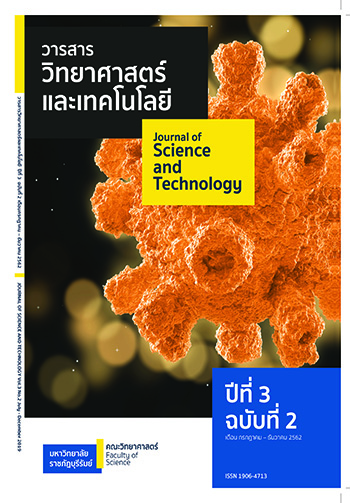ฤทธิ์ต้านแบคทีเรีย Staphylococcus intermedius ของสารสกัดจาก พืชสมุนไพร
Main Article Content
บทคัดย่อ
พืชสมุนไพรถูกนำมาใช้เป็นยารักษาโรคต่าง ๆ ทั้งโรคติดต่อ และโรคไม่ติดต่อ โดยเฉพาะโรคติดเชื้อแบคทีเรีย การศึกษานี้ได้นำสารสกัดจากพืชที่มีฤทธิ์ยับยั้งแบคทีเรีย 4 ชนิด ได้แก่ ขิง ข่า ตะไคร้ และใบมะกรูด มาเตรียมเป็นสูตรผสมของสารสกัดจากพืชทั้งหมด 4 สูตร และตรวจสอบฤทธิ์ยับยั้งแบคทีเรีย Staphylococcus intermedius TISTR668 ด้วยวิธี Agar disc diffusion และวิธี Broth microdilution ผลการศึกษาพบว่า สูตรผสมที่ 2 ให้ฤทธิ์ยับยั้งแบคทีเรียได้ดีกว่าสูตรผสมอื่น โดยมีขนาดยับยั้งเท่ากับ 28.02±0.31 มม. และให้ค่าการยับยั้งแบคทีเรียน้อยที่สุดเท่ากับ 0.625 mg/ml และมีค่าการฆ่าแบคทีเรียน้อยที่สุดเท่ากับ 0.625 mg/ml สูตรผสมที่ได้จากการวิจัยนี้สามารถนำไปพัฒนาเป็นส่วนผสมในผลิตภัณฑ์ สำหรับดูแล และควบคุมการติดเชื้อแบคทีเรียได้
Article Details
เนื้อหาและข้อมูลในบทความที่ลงตีพิมพ์ในวารสารวารสารวิทยาศาสตร์และเทคโนโลยีถือเป็นข้อคิดเห็นและความรับผิดชอบของผู้เขียนบทความโดยตรงซึ่งกองบรรณาธิการวารสาร ไม่จำเป็นต้องเห็นด้วย หรือร่วมรับผิดชอบใด ๆ
บทความ ข้อมูล เนื้อหา รูปภาพ ฯลฯ ที่ได้รับการตีพิมพ์ในวารสารวารสารวิทยาศาสตร์และเทคโนโลยีถือเป็นลิขสิทธิ์ของวารสารวารสารวิทยาศาสตร์และเทคโนโลยีหากบุคคลหรือหน่วยงานใดต้องการนำทั้งหมดหรือส่วนหนึ่งส่วนใดไปเผยแพร่ต่อหรือเพื่อกระทำการใด ๆ จะต้องได้รับอนุญาตเป็นลายลักษณ์อักษรจากวารสารวารสารวิทยาศาสตร์และเทคโนโลยี ก่อนเท่านั้น
เอกสารอ้างอิง
มณฑล วิสุทธิ. (2560). “ฤทธิ์ต้านแบคทีเรียกลุ่ม Staphylococci ของสารสกัดจากพืชท้องถิ่นบางชนิดในจังหวัดนครราชสีมา,” วารสารวิทยาศาสตร์ มข. 45(4) 805-816.
Clarke, S. (Ed.). (2009). Essential Chemistry for Aromatherapy E-Book. Elsevier Health Sciences.
Abirami, A., Nagarani, G., & Siddhuraju, P. (2015). “Hepatoprotective effect of leaf extracts from Citrus hystrix and C. maxima against paracetamol induced liver injury in rats,” Food science and human wellness. 4(1) : 35-41.
Bhargava, S., Dhabhai, K., Batra, A., Sharma, A., & Malhotra, B. (2012). “Zingiber officinale: Chemical and phytochemical screening and evaluation of its antimicrobial activities,” Journal of chemical and pharmaceutical research. 4(1) : 360-364.
Chusri, S., Tongrod, S., Chokpaisarn, J., Limsuwan, S., & Voravuthikunchai, S. P. (2014). “Antagonistic interactions of “Ya-Sa-Marn-Phlae” ethanol extract in combination with topical antiseptics against clinical isolates of Staphylococcus aureus,” BioMed research international. 2014.
Clinical and Laboratory Standards Institute (CLSI). (2009). Methods for Dilution Antimicrobial Susceptibility teste for Bacteria That Grow Aerobically; Approved Standard-Eighth Edition. USA : Clinical and Laboratory Standard Institute, Wayne, Pa.
Iverson, S. A., Brazil, A. M., Ferguson, J. M., Nelson, K., Lautenbach, E., Rankin, S. C., Morris, D. O., Davis, M. F. (2015). “Anatomical patterns of colonization of pets with staphylococcal species in homes of people with methicillin-resistant Staphylococcus aureus (MRSA) skin or soft tissue infection (SSTI),” Veterinary Microbiology. 176(1) : 202–208.
Karunarathne, P. U. H. S., Thammitiyagodage, M. G., & Weerakkody, N. S. (2018). “Safety evaluation of galangal (Alpinia galanga) extract for therapeutic use as an antimicrobial agent,” International journal of pharmaceutical
sciences and research. 9(11) : 4582-4590.
Kondo, S., Sattaponpan, C., Phongpaichit, S., Srijan, A., & Itharat, A. (2010). “Antibacterial activity of Thai medicinal plants Pikutbenjakul,” Journal of the Medical Association of Thailand. 93(7) : S131-5.
Lee, J. (1994).”Staphylococcus intermedius isolated from dog-bite wounds,” Journal of Infection. 29(1) : 105.
Lilenbaum, W., Veras, M., Blum, E., & Souza, G. N. (2000).”Antimicrobial susceptibility of staphylococci isolated from otitis externa in dogs,” Letters in applied microbiology. 31(1) : 42-45.
Moon, J. S., Lee, A. R., Kang, H. M., Lee, E. S., Kim, M. N., Paik, Y. H., & Koo, H. C. (2007).”Phenotypic and genetic antibiogram of methicillin-resistant staphylococci isolated from bovine mastitis in Korea,” Journal of dairy science, 90(3) : 1176-1185.
Oonmetta-aree, J., Suzuki, T., Gasaluck, P., & Eumkeb, G. (2006). “Antimicrobial properties and action of galangal (Alpinia galanga Linn.) on Staphylococcus aureus,” LWT-Food Science and Technology. 39(10) : 1214-1220.
Plengsuriyakarn, T., Viyanant, V., Eursitthichai, V., Tesana, S., Chaijaroenkul, W., Itharat, A., & Na-Bangchang, K. (2012). “Cytotoxicity, toxicity, and anticancer activity of Zingiber officinale Roscoe against cholangiocarcinoma,” Asian Pacific Journal of Cancer Prevention. 13(9) : 4597-4606.
Rahman, S., Parvez, A. K., Islam, R., & Khan, M. H. (2011). Antibacterial activity of natural spices on multiple drug resistant Escherichia coli isolated from drinking water, Bangladesh. Retrieved Jan 5, 2017, from https://doi.org, 10.1186/1476-0711-10-10
Rios, J. L., & Recio, M. C. (2005). “Medicinal plants and antimicrobial activity,” Journal of ethnopharmacology. 100(1-2) : 80-84.
Sasidharan, I., & Menon, A. N. (2010). “Comparative chemical composition and antimicrobial activity fresh & dry ginger oils (Zingiber officinale Roscoe),” International Journal of Current Pharmaceutical Research. 2(4) : 40-43.
Singh, G., Kapoor, I. P. S., Singh, P., de Heluani, C. S., de Lampasona, M. P., & Catalan, C. A. (2008). “Chemistry, antioxidant and antimicrobial investigations on essential oil and oleoresins of Zingiber officinale,” Food and chemical toxicology. 46(10) : 3295-3302.
Sunilson, J. A. J., Suraj, R., Rejitha, G., Anandarajagopal, K., Kumari, A. V. A. G., & Promwichit, P. (2009).”In vitro antimicrobial evaluation of Zingiber officinale, Curcuma longa and Alpinia galanga extracts as natural food preservatives,” American Journal of Food Technology. 4(5) : 192-200.
Temrangsee, P., Kondo, S., & Itharat, A. (2011). “Antibacterial Activity of Extracts from Five Medicinal Plants and Their Formula Against Bacteria that Cause Chronic Wound Infection,” Journal of the Medical Association of Thailand. 94(1) : 166-171.
Tomlin, J., Pead, M. J., Lloyd, D. H., Howell, S., Hartmann, F., Jackson, H. A., & Muir, P. (1999). “Methicillin- resistant Staphylococcus aureus Infections in 11 Dogs,” The Veterinary Record. 144(3) : 60-64.
Van Vuuren, S. F. (2008). “Antimicrobial activity of South African medicinal plants,” Journal of ethnopharmacology. 119(3) : 462-472.
Visutthi, M. (2016). “Anti-bacterial and Anti-quorum Sensing Properties of Selected Medicinal Plants from Nakhon Ratchasima Province, Thailand,” Science and Technology RMUTT Journal. 6(1) : 1-13.
Voravuthikunchai, S. P., Limsuwan, S., Supapol, O., & Subhadhirasakul, S. (2006). “Antibacterial activity of extracts from family Zingiberaceae Against Foodborne Pathogens,” Journal of Food Safety. 26(4) : 325-334.
Wedley, A. L., Dawson, S., Maddox, T. W., Coyne, K. P., Pinchbeck, G. L., Clegg, P., & Williams, N. J. (2014). “Carriage of Staphylococcus species in the veterinary visiting dog population in mainland UK: Molecular characterization of resistance and virulence,” Veterinary microbiology. 170(1) : 81-88.
Worthing, K. A., Brown, J., Gerber, L., Trott, D. J., Abraham, S., & Norris, J. M. (2018). “Methicillin-resistant staphylococci amongst veterinary personnel, personnel-owned pets, patients and the hospital environment of two small animal veterinary hospitals,” Veterinary microbiology. 223(1) : 79-85.


